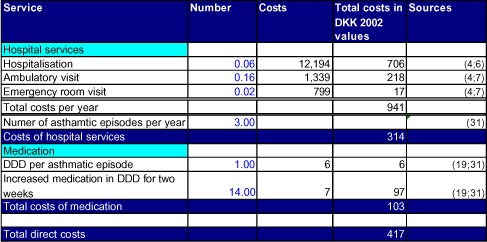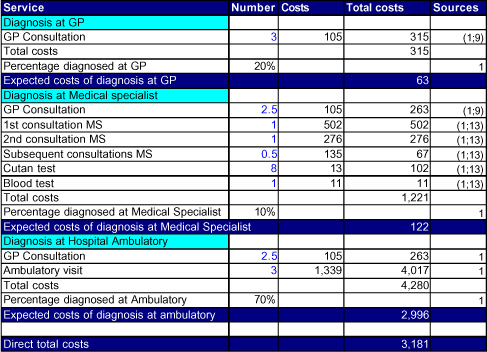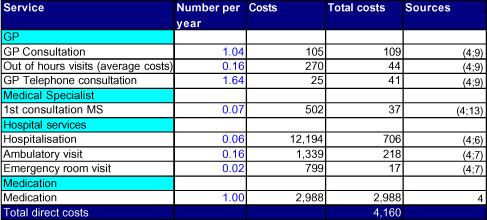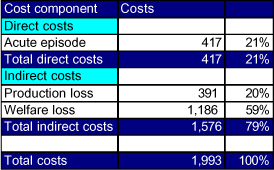|
Valuation of Chemical related Health Impacts 5 Asthma bronchialeThe symptoms of asthma bronchiale are repeating attacks of difficulty in breathing, coughing with phlegm or hissing breathing. The reaction can be reduced by avoiding certain substances and by taking in preventive medicine. By serious attacks the patient must seek help by the doctor or emergency room. 5.1 DefinitionAsthma bronchiale is a pulmonary disease characterized by reversible airway obstruction, airway inflammation, and increased airway responsiveness to a variety of stimuli. Asthma bronchiale is classified as J45 (Asthma bronchiale) in the ICD-10 classification of diseases. Starting age for the disease is assumed to be at the age of 40. 5.2 Chemicals associated with Asthma bronchialeFor asthma it is relevant to distinguish between the disease asthma and an asthmatic episode. It is very rare that chemicals will cause the disease asthma. Mosbech assesses that this is the case in less than 1 % of the incidences (Mosbech (2003)). Instead, chemicals are more likely to be irritants causing an asthmatic attack for people with asthma. 5.3 Disease courseTwo different disease courses are relevant for chemicals related to asthma patients.
As indicated, the former is the most relevant in relation to chemicals. In order to address, however, the need for various applications of the cost estimates, costs will be estimated for the following components:
In general, asthma treatment can be grouped in to the following categories11:
Diagnosis relates to the process of diagnosing the patient, long term management is the daily treatment for managing the disease, and acute care is treatment related to an asthmatic episode. An asthmatic episode is defined as an asthmatic episode which acquires treatment not included in the long term management; i.e. additional medication, emergency room visit, hospitalisation, etc (Mosbech (2003)). The average person with asthma will have 3 asthmatic episodes per year (Mosbech (2003)). In relation to chemicals, it is difficult to assess the number of asthmatic episodes. When the chemicals causing asthmatic episodes are removed, the person will no longer experience asthmatic episodes. Therefore, it is not possible to estimate or asses the average number of chemical induced episodes a person will experience every year. This will depend on the intensity and number of exposures during the year. 5.4 Direct costsCost per asthmatic episodeWhen a patient has an asthmatic episode, the patient will take medication to relief the symptoms and in some cases seek medical assistance. With respect to medication, the patient will typically take 1 DDD (Defined Daily Dose) of Selective beta-2-adrenceptor agonists (ATC-group R03AC) to treat the acute episode (Mosbech (2003)). In addition to this, the patient will for two weeks take double dose (2 DDD per day) of the medication used for daily treatment. Therefore, 1 DDD per day for two weeks can be attributed to the asthmatic attack. In the calculations, the costs of medication are made separately for the two kinds of medicine (Lægemiddelstyrelsen (2001);(2003)). Costs of hospitals services are based on the average use of hospital services for asthmatic patients (moderate to severe patients) within one year (Søndergaard et al. (2000)). Costs of use of GP (General Practitioner) services were not included. The use of these services could not be attributed to the asthmatic episodes per see as they were assessed to reflect routine visits only. Table 5-1 Direct costs per asthmatic episode (DKK in 2002 values)
Costs of medication are public expenditures only The total direct costs of an asthmatic episode are estimated to be DKK 417 (Table 5-1). Approximately 75% of these costs reflect use of hospital services. Cost of diagnosisThe GP refer patients to either Medical Specialist or Hospital Ambulatory. The Medical Specialist seldom refers does not refer patients to Hospital Ambulatory for diagnosis (Mosbech (2003)). Table 5-2 Costs of diagnosis for asthma patients (DKK 2002 values)
GP General Practitioner 70% of the patients are diagnosed at the Hospital ambulatory. For a patient being diagnosed at the Hospital ambulatory, total costs are DKK 4,280. Since this is the case for 70% of the patients, expected costs are DKK 2,996. When including costs of GP and Medical specialist, direct total costs of establishing the diagnosis are DKK 3,181. Costs of daily treatmentCosts of daily treatment reflect the average use of services within a year. This includes services related to asthmatic episodes, preventive medication and routine visits to GP. Table 5-3 Yearly costs of treatment for asthmatic patient (DKK 2002 values)
Costs of medication are public expenditures only Total direct costs are DKK 4,160 for one year (Table 5-3). As seen from the calculation, the most important component is costs of medication with DKK 2,988 per year. 5.5 Individual welfare lossThe welfare loss value is based on Navrud (1997/2000). In his survey the respondents were asked about their WTP for avoiding an additional day of asthma attack. The objective of Navrud (1997/2000) was to valuate the individual WTP to avoid seven light health symptoms and asthma. The method was a contingent valuation (CV) study, where 1,009 Norwegians were asked about their preferences. First, people were asked to evaluate their overall health state, and whether they could do anything to influence their own health. Then they were asked how many days they experienced having each of these seven "light" symptoms and asthma the last 12 months, how it had restricted their activities, and their private costs of having these symptoms. Next, they were presented by cards describing the symptoms and were asked to rank them. The respondents were divided into two subsamples. One was asked about the WTP to avoid one additional day having the symptoms within the next 12 months, whereas the other subsample was asked about the WTP to avoid 14 days having the symptoms. As expected, the results showed declining marginal value of a symptom day comparing the two subsamples. The average WTP per symptom day from subsample B (14 additional symptom days) was 18-32% of the value of a marginal symptom day found in subsample A. Mean values are in general higher than the corresponding median values due to the high variance in the WTP of the people asked. Whereas the median values probably accord better with most people's introspection, the mean value takes into account the people that have much higher WTP than most people e.g. because they cannot take the medicine needed etc. For the present purpose the mean values are used. For asthma, the answers were divided on people with asthma and people not having asthma. Persons with asthma were willing to pay DKK 1,297 (2002-prices) whereas person without asthma were willing to pay app. the half, DKK 625. For further description of the survey we refer to Navrud (1997/2000). The estimates were discussed with an expert of asthma (Dr. Med. Holger Mosbech), who found the estimates as well as the differences between the answers of the two categories of respondents appropriate. The reason for the relative high WTP of asthmatics compared to non-asthmatics may be that asthmatic people know about the actual inconvenience and especially the fear of death that often appear in connection with a serious asthma attack (even though very few patients die from an attack). Otterström et al. (1998) estimated the WTP of avoiding a day of asthma attack to only DKK 156 per day, which seems rather low according to the expert statement of the present study. Since chemical induced asthma attacks normally occur for asthmatic people only seems most reasonable to use the WTP from asthmatic people in the present context. Corrected for income and purchasing power, the WTP estimate used in the present context is DKK 1,186. 5.6 Production lossIn Søndergaard et al. (2000) it is estimated that the average number of days absent from work due to asthma is 2.2 days per year. Based on expert judgement it is assumed that the number of attacks per year is 3 in average. This results in 0.73 days absent from work per asthma attack. Consequently, the production loss per asthma attack will be DKK 391. This approximately means that each attack results in a day of sickness. The reason of using 0.73 day per attack and not 1 day per attack is due to the fact that some attacks will arise during non-working days. 5.7 Unit cost estimate5.7.1 Costs per asthmatic episodeThe total unit cost of an asthmatic episode is DKK 1,933. The direct costs are DKK 417 and indirect costs are DKK 1,576. Thus, the indirect costs are responsible for 79% to the total unit costs. Table 5-4 Total costs per asthmatic episode (DKK 2002 values)
5.7.2 Lifetime costsIn order to illustrate potential costs over a number of years, lifetime costs for a person who acquire chemical induced asthma are estimated (Table 5-5). The example is made for a at 40 years old person acquiring asthma and assuming 3 asthmatic episodes per year. Table 5-5 Lifetime costs of asthma (DKK 2002 values)
Age of onset is 40 Total lifetime costs of asthma are DKK 201,886 (3% discount rate). Direct and indirect costs are responsible for approximately half of the total costs respectively. Footnotes11 The probability of dying from asthma is very low and is omitted in the following calculations According to EPA in the US, the annual probability of dying from asthma is 0,0004 (EPA (2000)).
|




